 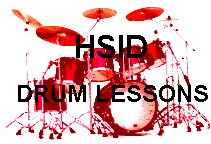

Lesson Menu #2
Intermediate & Advanced.
Lesson Menu #3
Advanced & Ultra-Advanced.
Lesson Menu #4
Text lessons: All levels.

PRODUCTS:

GET ALL THE PRODUCTS AT ONE LOW PRICE.

SURPRISES ABOUND . . . For those with a bit of generosity
in their soul.
CLICK HERE , to see what I mean.

Intermediate & Advanced
Drummers
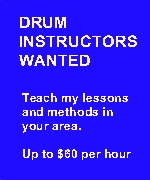 Your future is waiting.
Your future is waiting.

ALL MUSICIANS
MASTER
ALL RHYTHM,
This FASCINATING WAY!
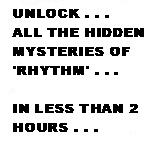 Discover the 'LOST KEY' for Unraveling
ALL the mysteries of rhythm, and musical time.
Discover the 'LOST KEY' for Unraveling
ALL the mysteries of rhythm, and musical time.
This work
is the crowning-achievement of my 50 year career, and it's
my proudest accomplishment.
It contains the potential to help YOU change the face of modern music!
You'll love it! CLICK HERE to check it
out completely! You're in for a MAJOR surprise!
 "PRE-SCHOOL DRUMMER?
"PRE-SCHOOL DRUMMER?
YES!"
Can we teach rhythm
to pre-schoolers? YES!
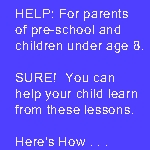
This is a very short course,
designed to help adults plant the seeds of rhythm
into children of nearly any age.
CLICK HERE
 FREE ELECTRONIC BOOK BONUS (also included)
FREE ELECTRONIC BOOK BONUS (also included)
 BUSINESS OPPORTUNITY:
BUSINESS OPPORTUNITY:
MAKE BIG MONEY SELLING USED DRUMSETS!
* INSIDER HARDBALL-BUYING-TIPS AND SECRETS.
* UNIQUE RECOVERING SECRETS

Support this site and and gain an advetising bargain with the deal.
 Place a permanent ad here. Place a permanent ad here.

GET ALL THE PRODUCTS AT ONE LOW PRICE.

SURPRISES ABOUND . . . For those with a bit of generosity
in their soul.
CLICK HERE , to see what I mean.

|
|
Downloads *
Drummers Trivia *
Drummers Chat Rooms *
Rudiments *
Digital Music *
Knowledge Assessments *
TD Archives *
Drum Set Buyers Guide *
Bass-Player Jokes *
Assembling a Drum Set *
Parts of a Drum Set *
About HSID *
Video Troubleshooter
Bill Powelson's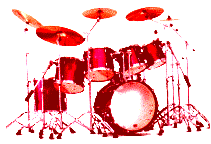 School of Drums
School of Drums
Back to the Tempo Dispatch Archives
Issue #13___\__\__\__\__\__________/__/__/__/__/ January 1998
___________________________________________________
TABLE OF CONTENTS
What is in this issue?
Contents:
1. Feature Article: NEW YEARS RESOLUTION!
Learning to Write & Read drum notation.
2. Humorous Story of the Month
________________________________________________________
FEATURE ARTICLE
(A New Years Resolution)
Mastering the Art of Writing & Reading Drum Notation
A brand new year! Let's make a resolution to push ahead
into the unknown . . .
This month I want to show you still another career possibility
behind the drumset. TEACHING! It all begins the day you learn
to communicate rhythms in black and white. Today is that day!
LEARN TO COMMUNICATE, THEN TEACH!
Yes, YOU can teach! Even if your only student is the cynic
who scoffs at you in the mirror every day!
Dump your negative attitudes in the trash, follow along for a
few minutes and by the time you finish this article, you'll be
overwhelmed. It is soooo much easier than you think!
Get into the habit of writing rhthms daily, even if you aren't
writing them exactly by the book! The minor imperfections will
dissapear in no time!
Find a friend who has an interest in drums and begin teaching
them for the sheer fun of it! Extrodinary things happen as you begin
to explain what you know to someone else . . . sometimes you will
learn more than your student!
QUESTION: WHY LEARN TO READ & WRITE DRUM NOTATION?
I know this sounds like a dumb question to many of you.
None-the-less, it is amazing how many professionals drop the ball
and run for cover when the subject of writing and reading comes
up.
Most of us are seat-of-the-pants jammers! I am one of those
myself! I beleive jamming is the key to everything . . .
BUT, it is also VERY important to acknowledge the fact that
our ability to accellerate the learning process will depend on those
black and white communicating skills. If you can write and read a
little, a whole new world will open up. For one thing, you will
gain the ability to steal and retain licks from all the competiton.
Sometimes, stealing is the best way to learn. Likewise, everything
you steal can be converted into a lesson that might help someone
else. These are some pretty good reasons for learning to write
and read!
Notation is a learning tool! Nothing more and nothing less!
Without the ability to write & read, your learning curve will be
immeasureably stunted. So stop groaning and let's get started!
STEP I: Thow out all the books!
We are going to try a whole new concept! The idea here is
to make a boring subject fun and easy . . .
You may have noticed that I keep putting the word 'write'
before the word 'read'. That is because I have made a few discoveries
that will help many of you (jammers) forget all your writing/reading
phobias. In this way, I hope to lead you into an entirely new world
that will fire your imagintion with literally millions of new rhythmic
ideas. These new ideas will hopefully find their way into your jamms
and you will gain in three ways . . .
1. First, you will learn to write . . . which will
help you to visualize rhythms previously unknown.
2. Writing will automatically and effortlessly teach
you to read . . .
3. Those discoveries will lead to better recall and
more creative jamms!
So . . . as you digest this lesson, it is my hope that your
creative improvosational (jamming) abilities will also enjoy a breath
of new life too!
REMEMBER THIS!
IF YOU CAN PLAY IT, YOU CAN WRITE IT! IF YOU CAN WRITE IT, YOU
WILL ALSO BE ABLE TO READ IT! Profecient writing will lead to profecient
reading, almost naturally!
GATHER YOUR WRITING MATERIALS:
Reach over to the printer stand and steal a clean white sheet
of paper from the stack, then scrounge through the desk drawer and
find a pen or pencil . . .
ANOTHER WAY:
Better yet! If you know the 'Control/Tab' trick on your computer,
simply open your word processor and use it. Use the Control/Tab trick
to switch back and forth between this note and your word processor.
Whatever you do . . . get ready to write!
WRITING YOUR FIRST BEATS:
We are going to start real simple but in only a few minutes
you will discover the ability to write 4.3 billion new rock beats.
4.3 billion is a hefty number, that's true. We won't do them all,
but you will understand how to write & read any of them in only a
few minutes.
The first thing we will do is lay out 3 horizontal lines about
two inches in length. Like this . . .
__________________________
__________________________
__________________________
Each end of this little music staff needs a vertical bar
to designate that this is one whole measure. It is difficult
to draw a vertical bar using the computer so we will live without
it for now.
Now place 4 evenly spaced Xs on the top line. We are
writing the Hi-Hat (or cymbal) line, like this . . .
_____X____X____X____X_____ CYMBAL OR HH
__________________________
__________________________
There are 256 potential rhythms staring you in the face
right this minute, but to keep everything on a practical level,
lets' add a snare note to help diminish the numbers while pointing
out the most common beat patterns within this framework.
It will all explode in a minute, but for now
let's place an S (snare) on the center line, below the third X,
like this . . .
_____X____X____X____X_____ CYMBAL OR HH
_______________S__________ SNARE
__________________________ BASS
-----------------------------------------------------
NOTE: If you know the 'Select', 'Copy' & 'Paste' trick
on your computer . . . you can just steal the above
pattern from here and put it in your word processor.
-----------------------------------------------------
Just for kicks, play what you have written! Pretty lame,
I know but get ready to think! We are going to visualize a
mountain of stuff, then write and play it too!
STEP 1: Experimenting with the Bass Possibilities!
Begin to experiment with bass drum possibilities while
keeping the snare in its current position . . .under the third
cymbal.
The bottom line is for the bass drum. You can
place a bass note ANYWHERE you wish on the bottom line and it will
always produce a functional beat pattern. By functional, I mean that
all these permutations (variations) will work well with routine 8th rock
jamms or with the everyday rock songs you hear on the radio.
EXAMPLES:
_____X____X____X____X_____ CYMBAL OR HH
_______________S__________ SNARE
_____B____B_______________ BASS
OR
_____X____X____X____X_____ CYMBAL OR HH
_______________S__________ SNARE
__________B_______________ BASS
Can you visualize the others? There are 16 total possibilities!
As you try playing these rhythms, be sure to repeat each one
several times.
WHAT IS A SYNCOPATION?
For now, we aren't concerned with syncopations. A syncopation
(or sync) occurs when we drop a note (bass or snare) BETWEEN any
two cymbal notes. Syncs get complex in a hurry. First, just concentrate
on simple variations. In other words, line your bass notes up with
a cymbal note . . . ANY CYMBAL NOTE! Write a simple example . . . then
play it. Then another and another. You will discover 16 neat rock
variations if you play with all the possibilities. Each of these beats
are fundamental elements of the rock era. Millions of your
favorite songs are using these same beat examples right now!
STEP 2: Experiment With the Snare
Let's continue on with the next most logical step. Place a bass
note below the first cymbal (on the third horizontal line). Now we will
leave that bass note in place while experimenting will all the snare
possibilities. You need to visualize, write and play each one. There
are 16 of these too! Can you visualize, write and play all 16? Send
E-mail if you can't figure them out!
The same 16 possibilities exist no matter which line we are
talking about.
EXAMPLE:
_____X____X____X____X_____ CYMBAL OR HH
_______________S____S_____ SNARE
_____B____________________ BASS
Use your imagination! Don't give up until you see all 16
variations.
STEP 3: 16 Bass variations X 16 Snare variations
Now you are ready to play with all 256 possibilities! Pick
any of the 16 Snare patterns, one at a time and place them with
any of the 16 Bass patterns, one at a time.
EXAMPLE:
_____X____X____X____X_____ CYMBAL OR HH
__________S____S____S_____ SNARE
_____B____B_______________ BASS
WARNING: You are not a spaz . . . some of these more complex
beat patterns are virtually impossible for all us mono-brained
humanoids! Few drummers can actually play all the remaining beat
patterns. Playing each one isn't the important thing. Visualization
is what counts! Try to write and play a large portion of the 256
variation possibilities. Get the picture, then move on.
Now for a BIGGER explosion . . .
STEP 4: Writing Whole Measure 8th-note 4/4 Patterns
So far, we have been examining 8th note 2/4. 2/4 is simply
a half measure of 4/4. Two bars of 8th 2/4 = one bar of
8th 4/4 . . . Get it? In other words, if you stretch your music
staff out a couple more inches and place 8 Xs on the top line, then
visualize the variation possibilities, you will arrive at a potential
65,536 individual 8th-note rock beat patterns. 8th note 4/4 is really
no harder to write than 8th 2/4.
EXAMPLE: (8th note 4/4)
____X____X____X____X____X____X____X____X_____ CYMBAL OR HH
_________S____S______________S____S__________ SNARE
____B______________B____B______________B_____ BASS
If we double everything again as in two bars of 8th note 4/4
or one bar of 16th 4/4 we will arrive at a total of 4,294,967,296
(or approx. 4.3 billion) individual beats. More on that next month
. . . be thinking about it! The only real difference between 2 bars
of 8th note 4/4 and one bar of 16th 4/4 is the placement of the (snare)
backbeat.
BACKBEATS:
The backbeats will fall on cymbal numbers 3 & 7 in 8th
4/4. But, when playing or writing 16th 4/4 the backbeats will fall on
cymbal notes #5 and # 13. This lends a completely different feel
to the rhythmic variables.
FOR THE SAKE OF SIMPLICITY, KEEP A SNARE NOTE ON THE BACKBEAT:
In the beginning it is probably best to always place a snare
on the backbeats. However, some of the most interesting rhythms
may often contain a rest on the backbeat. This can be done, if the beat
flow doesn't become disrupted. In other words, it is ok to rest on a
backbeat but it will confuse the rhythm if you lose track of where
the backbeat is supposed to fall. For this reason, we don't want to
rest too often on the backbeats. Wait awhile before experimenting
with patterns that omit the backbeat.
NOTE VALUES, SYMBOLS & TERMINOLOGY:
At the moment we are just placing Xs on paper. To become a
profecient writer, you will need a working knowledge of note values
and corresponding rests, etc.
Slowly, you will learn to equate the values of the different
types of notes (note values), then ad stems & flags. You will be
amazed at how quickly all this will come together if you just
continue to doodle with the notation possibilities.
NOW, THE NASTY MATH . . .
Each line of music on the music staff is supposed to tally
with the time signature. It is math and everything must
add up. For example, in the case of 8th note 2/4, we see four
Xs on the top line. In actuallity these are four 8th notes.
Mathmatically, we know that 4/8ths = 2/4. That adds up just fine!
But, If we represented three 8ths or five 8ths on that line,
things just wouldn't add up to 2/4. We would be in 3/8 or 5/8
time (respectively). Be thinking about that but don't
worry if it isn't all that clear yet. If you just continue to
write and juggle the notes around on paper, your own natural
logic will take over and save the day.
Remember also, that each note value has a corresponding rest.
Rests allow us to remain silent or skip a note, yet account for the
time in such a way that everything will still add up and match the time
signature we are in.
This stuff is a tad dry but you are going to need it!
In a minute I will send you to the NOTE VALUE lesson at the
website. This will help prepare you for next months continuation
of this lesson on writing notation. Before I send you to that lesson
though, let me point out that many people have a difficult time with
this area of study. If you are one of those, take heart! Just try
to get a general idea of how the different types of notes are used
to describe different rhythms within a steady tempo. If you tend to
freeze up with all this just keep thinking . . . and DON'T MISS next
months continuation of the lesson. It will all come together slowly.
Visit (and memorize) all the 'Note Values, Symbols & Rests'
at this website lesson.
Get what you can from it! Try to play the various note value
examples at the bottom of the lesson. Just kick a STEADY bass pattern
and try to play all the various notes on the snare as they appear in
the exercise. Notice how they look when written and how the rhythms
change as you move from one note value to the next. Don't concern
yourself too much with 'Half triplets' or 'Quarter triplets'. They are
confusing! You can go a long way without understanding them. The same
goes for '16th triplets' and '32nd notes' too.
Focus on playing a STEADY stream of bass drum counts while playing
WHOLE NOTES thru 16TH NOTES on the snare. If you understand that much,
next months lesson will be a sanap! :>)
PERMUTATIONS:
Well, you didn't know it but I also sneeked another lesson in on
you with this lesson. You just took a peek at 'Permutation' theory
and I only mentioned the word one time. It was a trick! :>)
Grab your dictionary and look up the word 'permutation', just
for kicks . . . then try to discern what it means to us drummers.
Permutation theory explains virtually every beat that exists
within the framework of our current 'Time Signature' system. When
you understand permutations completely, it is like a birdseye view of
all rhythm. You learn to see the entire forest rather than bouncing off
one tree at a time.
It is just the sort of thing that can make writing, reading
and TEACHING a breeze!
________________________________________________________
|________________________________________________________|
HUMOROUS STORY OF THE MONTH
Supposedly a true story...
Scene: A court room in Oklahoma where a person is on trial
for murder. There is strong evidence indicating guilt; however,
there is no corpse.
In the defense's closing statement the lawyer, knowing that his
client is guilty and that it looks like he'll probably be
convicted, resorts to a clever trick.
"Ladies and gentlemen of the jury, I have a surprise for you
all," the lawyer says as he looks at his watch. "Within 1 minute,
the person presumed dead in this case will walk into this court
room," he says and he looks toward the courtroom door.
The jury, somewhat stunned, all look on eagerly. A minute
passes. Nothing happens. Finally the lawyer says:
"Actually, I made up the previous statement. But you all looked
on with anticipation. I, therefore, put it to you that there is
reasonable doubt in this case as to whether anyone was killed and
insist that you return a verdict of not guilty."
The jury, clearly confused, retires to deliberate. A few minutes
later, the jury returns and a representative pronounces a
verdict of guilty.
"But how?" inquires the lawyer. "You must have had some doubt;
I saw all of you stare at the door."
Answers the representative: "Oh, we did look.
But your client didn't."
________________________________________________________
|________________________________________________________|
****************************
Your measure of yourself is VERY IMPORTANT! How do
you measure up as a person? This may offer a clue!
****************************
END OF TEMPO DISPATCH #13 January, 1998

Copyright Bill Powelson 1994 all rights reserved.
| |



